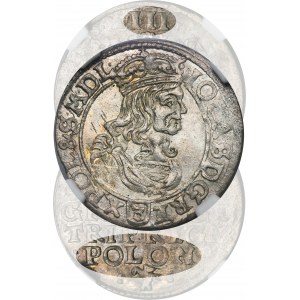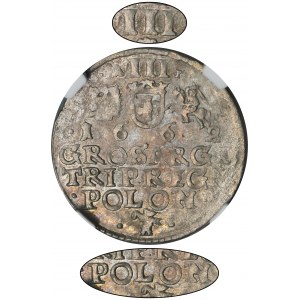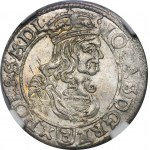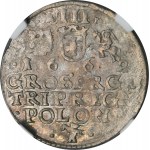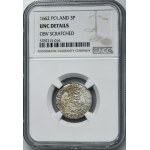Very rare Cracow trojak of John II Casimir.
Variety with bust with border and with POLON on reverse.
Onebid site only has one notation of this very rare variety.
Very well preserved, deeply minted. Scratch on obverse, hence no numerical grade from NGC, but this is a mint condition coin with lots of mint luster.
A needed and typologically sought after item from the mint of John II Casimir, and a great rarity in the variety presented.
At the beginning of the reign of Jan Kazimierz, an ambitious attempt at monetary reform took place (1650). A ban on the circulation of foreign money was introduced and the issuance of good own money began. It was then that copper shekels (wide) first appeared. The assumptions of the reform proved unrealistic so it was quickly withdrawn. Meanwhile, in Lithuania, which did not feel obliged to implement the 1650 reform (its representatives did not participate in the work of the commission), a parallel reform was introduced, based on other principles. In view of the Moscow invasion, the Vilnius mint worked only in 1652-1653. In turn, under the conditions of the Swedish Deluge, an important episode in the history of Polish minting was the launch of a makeshift crown mint in Lviv (1656-1657). The monetary relations of the Commonwealth tried to put in order the ordinance of 1658. The most notable for the period of the reign of Jan Kazimierz were the issues of subvalue money: small copper crown and Lithuanian shekels (so-called boratins) minted in the number of about 2 billion pieces, and zlotys (so-called tymfs), with an official value of 30 pennies - more than twice the actual silver content of the coin. Of the municipal mints in the period in question, there were mints in Gdansk, Elblag and Torun. John Casimir also exercised his minting rights as Prince of Opole and Racibórz (three-crore coins were minted at the Opole mint).
During the reign of Jan Kazimierz, trojaks were minted at five mints: Bydgoszcz (1650), Wschowa (1650), Poznan (1654), Krakow (1661?, 1662) and Vilnius (1652, 1664, 1665). Troyaks from the first three of the mints listed are among the great rarities. They are marked in catalogs as either unique or coins with a rarity grade of R8. The 1650 troikas were minted from good silver of the 14th-lower-mintage. They weighed an average of 0.934 grams and contained 0.817 grams of pure bullion. By 1652, the standard of trojaks had deteriorated significantly. VI-gold silver was now used in their production. The average weight of trojaks was 2,019 grams, and the pure silver content was 0.757 grams. In 1658, it was decided to further reduce the silver content of trojaks. The three values discussed above were now respectively: VI lav; 1.682 g; 0.631 g.
